Eric C. Sheninger's Blog, page 9
September 10, 2023
Developing Learning Walk Protocols
As I work with leaders across the globe, I am always careful with my words. There are rarely absolutes when it comes to educational leadership and ushering in meaningful change. The best course of action depends on the situation and context, which is rarely the same for different administrators. However, I am direct when it comes to what can be controlled. As a leader, you can control whether you make the time to visit classrooms to provide valuable feedback to your staff. So why does this matter in the larger scheme of things? I pulled the following from some research on the topic (Hardavella et al., 2017).
If we do not give feedback, this will come with a cost. The learner can assume that everything is fine and will continue practicing in the same way. This leads to a false assessment of their own skills and abilities and builds up a false perception.
It is hard to debate the value of learning walks when it comes to improving practice. In a previous post, I elaborated on the rationale for making them a consistent component of a leader’s day:
The process of learning walks, or walk-throughs as many schools refer to them, is to get a glimpse of what is happening in classrooms to then provide non-evaluative feedback for improvement. They serve an integral role as “soft” accountability mechanisms to spark conversations and reflections on practice. The more we observe and talk about practice, the better equipped we are to make and lead change. Another positive outcome of learning walks is the building of better relationships since the non-evaluative nature of the process focuses on meaningful growth around targeted look-fors.
When developing a learning walk protocol, consider the following:
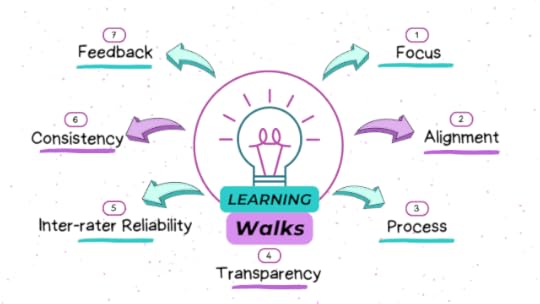
Focus
Determine a realistic number of practices that you would like to see during visits. These should be identified in your strategic plan for the academic year. Keeping things more general is also a good idea, as you can flesh out specifics during feedback conversations. When I facilitate learning walks with leaders that I support, I keep my list to five (5). However, you might find more value in focusing on less. Another good idea is to elicit input from teachers on where they feel feedback and support is needed.
Alignment
Try to align the look-fors to elements of the formal observation tool you use and expect to see routinely. We found that our teachers greatly appreciated that they would be receiving consistent support to prepare them for their three unannounced observations. My leadership team and I pulled specific elements that were core components of Tier 1 instruction.
Process
Create an easy-to-use form based on the look-fors that you establish. Google Forms are great for this as they can be set up to instantly graph the data, which can be shared with staff. In my coaching work with leaders, I help them develop a coding system for the strategies they are targeting, as this helps to make qualitative data collection much more manageable.
Transparency
Once you determine the focus for your learning walks, share the rationale and form with your staff. If educators are unclear or must guess what administrators are looking for, the process diminishes in value. Transparency helps to build trust and relationships in the process. Both will pay dividends during feedback conversations.
Inter-rater reliability
Everyone conducting learning walks must be on the same page. In addition to coming to a consensus on the areas of focus and co-developing the form, make the time to visit classrooms with a peer and then discuss what you saw and why. Regular leadership meetings can also be leveraged to ensure everyone is in lockstep.
Consistency
Once all the items above are addressed, it is time to get into classrooms regularly. Develop a schedule and stick to it as best you can. My admin team and I had to conduct five walks a day. Between the four of us, this came out to 100 visits a week, which resulted in a wealth of data to unpack.
Feedback
The entire purpose of learning walks is to help educators grow through non-evaluative feedback. If you visit classrooms and never engage in a dialogue about practices embedded in your strategic plan, then all you have accomplished is management by walking around. Determine how feedback will be provided to your staff. I suggest a two-pronged approach. First, curate the data collected and present during your faculty meetings, highlighting commendations and areas to consider for growth. Second, reach out to individuals where you have either seen outstanding practices in action or something that really needs attention from an improvement standpoint. Face-to-face conversations are typically the best, but you can also utilize phone calls, paper notes, or video conference tools. Try to limit feedback through email.
While I have found the elements above to be highly effective in my work with leaders to develop a learning walk process, keep in mind that you might find value in additional components. Regardless of what you settle on, flexibility is key. I shared the following in Digital Leadership:
With any learning walk form or tool, there must be a great deal of flexibility regarding how you use it. The most critical aspect of the learning walk process is what is done afterward to improve practice. Collaborative discussion as a leadership team about what can be improved as well as timely feedback to teachers are both crucial for success.
Getting into classrooms regularly was the best part of my day as a principal. It is also a highlight of the work I am blessed to engage in with leaders currently. Reflect on where you are with the learning walk process and how to make it a success. If I or my team at Aspire Change EDU can be of assistance, be sure to reach out (aspirechangeEDU@gmail.com)
Hardavella G, Aamli-Gaagnat A, Saad N, Rousalova I, Sreter KB. How to give and receive feedback effectively. Breathe (Sheff). 2017 Dec;13(4):327-333.
September 3, 2023
The Role of Content in Classrooms Today
Reflecting on my days as a student, I recall how the subject matter was the primary focus in every class. Whether delivered through lectures in college, direct instruction during K-12 education, or occasionally gleaned from textbooks and encyclopedias, it permeated every aspect of learning. Upon closer examination, it becomes evident that information, in the form of content, held a central role in all my classes. The routine was consistent: my peers and I would receive information and then be assigned tasks to showcase our comprehension, occasionally even constructing new knowledge. Essentially, the objective was to excel in exams.
I don't intend to undermine the value of content or curriculum; it serves as the foundation for progressing from basic to advanced learning levels. Indeed, mastering essentials such as letters and numbers is crucial for delving into language arts and mathematics, respectively. However, with the advancement of technology, learners can easily access content and information using various devices as they move through the education system. When considering artificial intelligence (AI), Alexa, Siri, and well-thought-out Internet searches, there is no end to how readily content can be accessed. This prompts the question: How significant is content truly in a knowledge-driven economy evolving rapidly due to technological strides?
Contemporary learners exhibit less compliance and conformity compared to earlier generations, and rightfully so. Whether engaged in authentic or pertinent learning, students naturally seek the underlying purpose and justification, an entirely reasonable sentiment. When content is imbued with purpose and applied in authentic ways to foster fresh insights, learners can articulate:
What they've learnedThe rationale behind their learningThe practical application of this knowledge both within and outside of educational contexts
Pertinent and purposeful instruction empowers students to leverage their knowledge to tackle multifaceted real-world challenges, often possessing multiple solutions. This shift in approach is pivotal and represents a move from instruction (what the teacher does) to learning (what the student does). Engaging in learning encourages students not merely to accumulate knowledge but to employ it for practical ends. Many aspire to apply their knowledge to address intricate real-world issues, creating projects, designs, and other tangible outcomes applicable to real-life scenarios. As I shared in Disruptive Thinking in Our Classrooms, the value of content is intrinsically linked to how it's utilized to foster purpose-driven thinking and application, which are both hallmarks of personalized learning.

While being adept at trivia might be advantageous for a game show like Jeopardy, its utility in real life is limited. Given the heightened stakes of today, it's imperative that we critically assess our methods to facilitate growth and enhancement. Nurturing a sense of purpose among our learners is a collective objective that will undeniably yield enduring benefits for their future endeavors.
August 20, 2023
Introducing Aspire Change EDU
I often get asked both through social media and in person how to become a consultant. For various reasons, educators are enamored by the keynoting circuit, facilitating presentations at both national and international events, and coaching in school systems. Initially, I had to pause and reflect before responding as I wanted to be very clear on how my journey was more complex than it might seem. Now I have a standard answer. I did not wake up one day and say that this is what I aspired to do for the rest of my career. It can also be stated emphatically that I was not looking to leave New Milford High School or was forced out. Instead, the path was carved for me through the efficacy-based work that my staff and I did when I was a principal.
In short, we vehemently focused on improving teaching, learning, and leadership through a shared vision, clarity of purpose, innovative practices, and clear evidence of impact. Our shared successes caught the eye of national media outlets as well as other systems that were curious about methodologies. What resulted were districts, schools, and organizations visiting my school from all over the world. I loved to share our successes, the challenges we overcame, student perspectives, and any other tidbits that might be valuable to those wanting to implement similar changes. During one such visit, an organization offered me a full-time position with their company. At first, I respectfully declined as I was happy where I was at in my career. However, the conversation never stopped, and I eventually decided to take a leap of faith to pursue a newfound passion in education.
It has been nine years since the consulting path was laid out for me. Over the years, I have worked with two amazing companies dedicated to helping learners succeed and traveling the globe assisting educators in various ways. While the work has been highly gratifying, there has always been an innate desire to carve out my own unique path in the education consulting space. My first step was to create an LLC during the pandemic.
It has laid dormant until the right time, which is now. With great pride and excitement, Aspire Change EDU has moved from vision to reality.
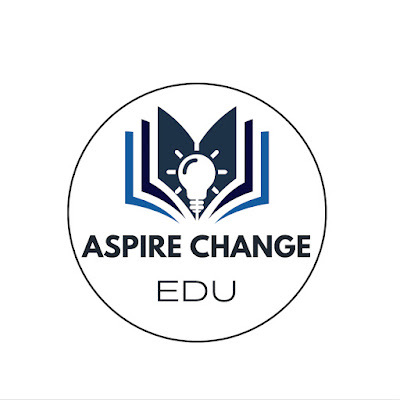
I have ambitious goals for my company. The first was to develop a name that embodies what consulting should be about, and that is to help systems aspire to change that leads to improving and enhancing what we already know works. Educators don’t want more things to do. They crave to maximize available time, strengthen their craft, help learners succeed, and find joy in the work. The logo above, co-created by my children Isabella and Nicholas, embodies this mission and vision.
During the initial phase of the company, I will be fulfilling many of the responsibilities, including:
Keynotes (view topics HERE)Back-to-school convocationsLeadership retreatsBreakout presentationsInteractive workshopsStrategic planningCoaching (job-embedded, ongoing)Asynchronous courses (more info HERE)Leadership and pedagogy will be my primary focus, which encompasses every facet of professional learning. Currently, my work with schools assists them with Tier 1 instruction, personalization, school culture, leadership (digital, pedagogical, sustainable change), using data, branding, and the purposeful use of technology. Over time I will flesh out concrete practice areas.
The last sentence above leads to what will be a differentiator for Aspire Change EDU. I aim to create a collaborative consultancy comprising best-in-class practitioners and seasoned consultants who share similar beliefs. While my plan is to have a bench of people to serve schools, I also want to partner with other independent consultancies (and vice versa) for the benefit of districts and schools. By working together, we can provide systems with what they want, not what we feel we can do. Imagine being matched with the best possible professional learning consultant(s) aligned to virtually every focus area, technique, initiative, tool, or strategy in education. That’s the goal and one that, in my opinion, best serves schools.
Just like for our learners, professional learning needs to be personalized and differentiated. It’s nearly impossible to accomplish this without collaboration. That is something I hope to solve in the near future with the help of others. In the end, schools will win and evidence-based change will be the result. Stay tuned for more updates in the coming months.
Until then, feel free to reach out and have a conversation about your professional learning needs. Learn more on my website.
August 6, 2023
Why Choice in Learning Matters
Do you like being told or directed to do something a certain way even though you know it doesn’t align with your innate strengths, interests, or learning preference? Pretty frustrating, right? It becomes even more of an obstacle to growth if you know how to demonstrate understanding but aren’t afforded different pathways to articulate a response. Choice matters when it comes to learning if that is the ultimate goal. The key is first to be open to giving up some control and understanding that, in many cases, there isn’t always one right way to demonstrate competency.
While educators can leverage many high-agency strategies, choice might be the most essential element of personalization because it allows students to take ownership of their own learning in so many different ways. When students have a say in what they learn, how they learn, and when they learn, they are more likely to be engaged and motivated. They are also more likely to see the relevance of their learning to their own lives and interests. Most importantly, when they are able to demonstrate understanding on their own terms, it builds invaluable confidence in their abilities.
I shared the following in Disruptive Thinking in Our Classrooms:
Choice is the great differentiator that helps meet the needs of all learners.
There are many ways to incorporate choice as a means to personalize. For example, students can choose their own learning:
Goals by involving them in setting individual goals, working with a group to set group goals, or choosing from a set of pre-determined goals.Materials such as a variety of textbooks, articles, websites, technology, or other resources to assist with or demonstrate learning.Activities such as hands-on activities, simulations, projects, or tasks in a choice board, playlist, or must-do/may-do list. During Tier 1 instruction, there are opportunities where students can choose to show their understanding using individual whiteboards or dry-erase surfaces (text, drawings) or technology (video, audio, drawing, text, images, etc.).Pace by setting their own deadlines for completing assignments, projects, or when working on a personalized task.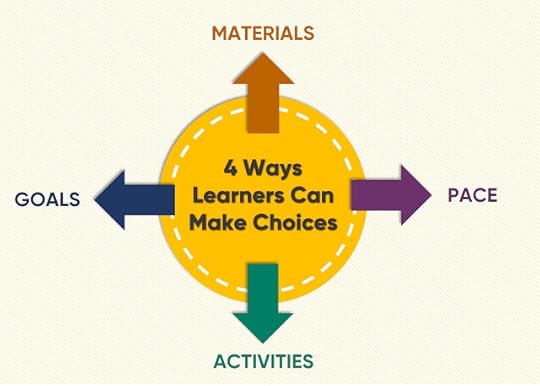
In my work with principal Nicki Slaugh and her Quest Academy Junior High School staff, student choice as a high-agency strategy has begun to flourish. Below you can see a few examples. I also encourage you to check out these posts from Wells Elementary (TX), Snow Horse Elementary (UT), Juab School District (UT), and the Corinth School District (MS).

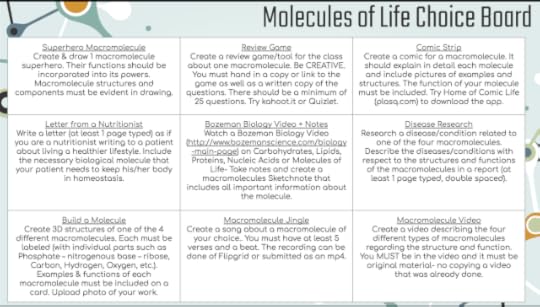
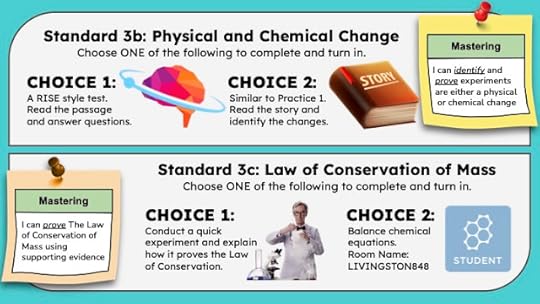

Giving students a choice in their learning can be a challenge, but it is worth the effort. While some might see it as more work or just another thing to do, once you find a schedule that works for you, choice can be integrated routinely, even if it is once a week. When students have a say in their learning, they are more likely to succeed. Here are some of the benefits of giving students choices in their learning:
Increased engagement and motivationImproved understanding of the relevance of learningIncreased self-regulation and directionEnhanced problem-solving skillsIncreased creativity and innovationImproved critical thinking skillsIf you are interested in incorporating choice into your classroom, here are a few tips:
Start small. Try to do only a little at a time.Be clear about your expectations. Let students know what they need to learn and how they will be assessed.Provide students with a variety of choices. This will help ensure that everyone can find something they are interested in.Be flexible. Be willing to adjust your plans based on student feedback.Celebrate student choices. When students make good choices, be sure to let them know.Share templates and ideas. Don't reinvent the wheel. Leverage your best resource, which is other educators invested in the work.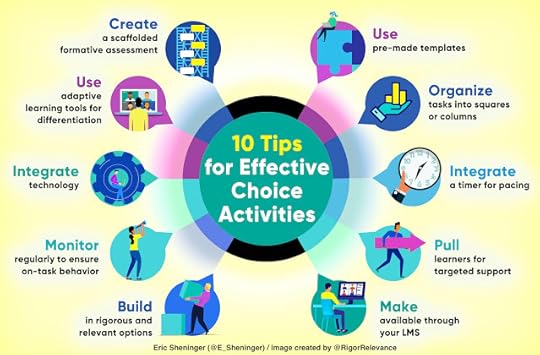
Giving students choices in their learning can be a powerful way to improve their engagement, motivation, and understanding. If you are looking for ways to personalize your classroom, I encourage you to give choice a try. For an array of strategies, check out this post.
July 30, 2023
How Pace Benefits All Learners
When you think about how you learn best, what comes to mind? Your response most likely flies in the face of how you were taught, and the same could be said of students today. If all kids are doing the same thing, the same way, at the same time, the experience is more impersonal than personal. It might work for some, but definitely not all. Learning is a process, not an event. It is more about the experience as opposed to a single lesson, curriculum, or assessment. So, what does or can, this look and feel like? In Disruptive Thinking in Our Classrooms, I defined personalization as ALL learners getting what they need, when and where they need it, to succeed. Time is a critical element in this process.
Pacing is an essential element of personalized learning because it allows all students to thrive. By enabling students to learn at their own pace, personalization ensures that all students have the opportunity to reach their full potential. Pacing is critical when it comes to personalized pedagogy because it affects a number of factors that are essential for learning, including:
Students learn at different paces. Not all students learn at the same rate. Some students may need more time to process information, while others may be able to learn more quickly. Pacing can impact engagement. When students are able to learn at their own pace, they are more likely to be invested in the learning process. This is because they are not forced to keep up with a group that is moving too quickly for them or to wait for a group that is moving too slowly.Pacing can affect understanding. When students are able to learn at their own pace, they are more likely to comprehend the material. This is because they have the time to process the information and to ask questions if they do not understand something.Pacing can increase motivation. When students see they are making progress, they are more likely to be empowered to continue learning. This is because they feel like they are in control of their own learning and capable of succeeding, which is a crucial tenant of ownership.In addition to these reasons, pacing is also vital for personalized learning because it allows students to focus on their strengths and interests. When students can learn at their own pace, they can spend more time on concepts they are interested in while concentrating more on areas of perceived difficulty. This can help them to develop essential competencies in those areas. Overall, pace is critical to personalized learning because it allows all students to succeed.
There are a number of ways to implement pacing in personalized learning. One way is to use a variety of learning activities that allow students to learn at different levels and at different paces. For example, some students learn best by reading, while others learn best by listening to lectures or doing hands-on activities. By providing a variety of learning activities, teachers can ensure that all students have the opportunity to learn at their own pace.
Another way to implement pacing in personalized learning is to use technology. Several software programs allow teachers to create personalized learning plans for their students. These programs can track students' progress and adjust the pace of learning accordingly.
Here are some tips for pacing in personalized learning:
Start by assessing students' individual needs. This will help you to determine how much time each student needs to learn the material. Consider common formative assessments, routine benchmarks, or the regular use of adaptive learning tools to get and then act on quality data. With useable data at their fingertips, educators can group, regroup, differentiate, target instruction, and implement Response to Intervention (RTI) with fidelity based on need. Implement a variety of learning activities. This will allow students to learn at different levels and at different paces. Sound pedagogical strategies such as station rotation, choice activities, playlists, and flipped lessons can be leveraged. Be flexible. Be willing to adjust the pace of the learning as needed. Consider using timers during tier 1 instructional activities as well as more robust pedagogical tasks.Provide regular feedback. This will help students to track their progress and to stay motivated.
Pace is a critical element of personalization because it allows students to exhibit more ownership of their learning. This is important because not all students learn at the same rate. Some students may need more time to process information, while others may be able to learn more quickly. By allowing students to learn at their own pace, personalized learning ensures that all students have the opportunity to succeed.
Keep these tips in mind so you can ensure that the pace of personalized learning is appropriate for your students and that they are able to learn effectively.
July 23, 2023
The Magnitude of Follow-Through
"It's the follow-through that makes the great difference between success and failure, because it's so easy to stop." - Charles F. Kettering
Have you ever made a commitment to do something, only to find yourself needing to follow through? How about getting motivated at a conference or professional learning, only to keep everything the same once you are back in your classroom, school, or district? What about promising students assignments would be graded within a specific timeframe only to not deliver on that promise? If so, you're not alone. While I still struggle with visualizing new ideas and how they will play out when acted upon, I have made a great deal of progress. Truth be told, many people struggle with follow-through, but it's a vital competency to develop.
There are many reasons why following through is essential. First, it shows that you're reliable and trustworthy. People expect you to keep your word and take action when you make a commitment or bold proclamation. If you don't follow through, you'll damage your reputation and make it harder for people to trust you in the future. From an individual standpoint, it helps you achieve your goals. When you establish where you want to go, you're more likely to reach it if you're able to follow through on the steps necessary to achieve it. If you keep putting things off or giving up on your goals, it becomes much harder to reach your full potential. Following through builds self-confidence. When you're able to complete a task or achieve a goal, it gives you a sense of accomplishment and makes you feel good about yourself. This can boost your self-confidence and make you more likely to take on new challenges.
Rina Koshkina shared the following advice:
There are many things in life that are out of our control, but you have full control over your ability to follow through. You are the only one who can choose to be consistent and proactive, creating the sense of accomplishment and closure for yourself and those around you.
You can do a few things to improve your willingness to follow through:
Breaking down your goals into smaller, more manageable steps is important. This will make them seem less daunting and more achievable.Set deadlines for yourself and stick to them. I can speak to how this dramatically helps me stay on track and avoid procrastination when writing, preparing presentations, and mapping out model lessons to facilitate when coaching.Find a way to stay motivated. Consider setting alarms on your phone, putting reminders into an online calendar, finding a colleague to work with, developing rewards for yourself, or simply reminding yourself why you want to achieve your goal.Following through is a skill that takes practice, but it's worth it. When you can follow through on your commitments, you'll be more successful in both your personal and professional life. You'll also build stronger relationships and gain a reputation for being reliable and trustworthy. So, if you want to improve your follow-through skills, start by breaking down your goals into smaller steps, setting deadlines, and finding a way to stay motivated. With a bit of practice, you'll be able to follow through on your commitments and achieve your goals.
In addition to the benefits mentioned above, following through can also help you to:
Develop disciplineLearn from your mistakesBuild resilienceGain a sense of control over your professional life
If you want to be successful in life, it's crucial to be able to follow through on your goals, responsibilities, and any other commitments. By following the suggestions in this post, you can achieve your goals while improving relationships in the process.
July 16, 2023
Artificial Intelligence (AI) for Leaders
You would be hard-pressed not to have heard how AI is evolving at such a fast rate. Tools like ChatGBT and Google Bard weren’t even a thing before 2023. With any innovation, there is both excitement and fear. While there is room for caution, leaders can tap into the power of AI. As I shared in Digital Leadership, evolving technology enables and empowers leaders to seize the moment and look for ways to fundamentally improve teaching, learning, and leadership.

Peer-reviewed research
Educators want a compelling why that imparts value when it comes to change. Look no further than using AI to conduct queries on any aspect of educational practice, such as grading, pedagogy, professional learning communities, virtual learning, or the use of technology. Be sure to specify that you are looking for peer-reviewed research that supports the practice you are trying to implement or change.
Observation comment library
Writing up observations can be a tedious process. To ease the burden as a principal, I would spend my summers developing a document containing concise commentary on virtually every strategy addressed in our observation and evaluation tool. I would then reference this when it was time to write everything up before the post-conference. AI can be used to create short narratives on any practice that you are evaluating your staff on, many of which are showcased in Disruptive Thinking in Our Classrooms. For example, you can ask why cooperative learning is a sound strategy and how to implement it correctly.
Streamline communication
Artificial intelligence (AI) can streamline communication and collaboration among leaders and their respective staff. For example, you can use it to:
Schedule meetings: AI can automatically suggest meeting times that work for building or district teams, all staff, departments, or PLCs. This saves time and hassle and helps ensure everyone is on the same page.Assign tasks: AI can automatically assign tasks within your leadership team based on their skills and availability. This helps ensure that tasks are completed on time and that everyone is contributing to the task(s) at hand.Provide updates on change efforts: AI can automatically generate progress reports related to strategic planning, implementation of initiatives, professional learning, and facilities updates. This can help all leaders stay on top of their work and identify potential problems.Tools like Bard and Chat GBT can be invaluable as part of your leadership toolbox. They can help save time, reduce errors, and ensure everyone is working towards the same goals. AI-powered chatbots can be used to answer questions, provide information, and resolve problems. This can free up people to focus on more complex tasks. Project-management tools with embedded AI can help to track progress, manage tasks, and collaborate on documents. This can help to improve efficiency and coordination. Finally, AI can provide a boost to analytics that can be used to track communication patterns, identify areas for improvement, and make recommendations.
Personalized feedback
AI can generate human-like responses tailored to individuals' specific needs and preferences. This can lead to increased engagement and satisfaction among your leadership team and staff, leading to increased productivity and efficiency. Here are some ways it can personalize the feedback process.
Provide tailored responses: AI can analyze someone’s work and provide feedback tailored to their strengths and weaknesses. This can help people improve their performance and to feel more supported.Suggest resources: AI can suggest resources relevant to someone’s interests or needs. This can help team members learn new skills, stay current on education trends, and find solutions to problems.Resolve issues: AI can be used to resolve issues between staff members. This can improve communication and collaboration and create a more positive work environment.By providing personalized feedback, suggesting resources, and resolving issues, AI can help educators feel more supported and valued. This can lead to increased productivity and efficiency, benefiting the entire organization.
While AI has potential pitfalls, leaders can harness its power to become more effective and efficient. It can improve communication, lead to a reduced sense of stress by taking routine tasks off your plate, and help to build trust with staff. With AI as a leadership tool, time will be freed up so you can be more human.
July 9, 2023
The Essence of Being a Leader
What is the essence of leadership? How do leaders effectively implement, sustain, and scale change? There is no shortage of responses regarding the topic, which is why questions are more important than answers. Narrowing down the most critical competencies can take time and effort. However, let’s look at it from the perspective of debunking what authentic leadership is, not to get at the heart of what it really is when it comes to agents of change.
The word "leader" is often paired with "follower." However, leadership is not about attracting others to follow. In fact, I think that this definition of leadership is outdated and limiting. Leadership is about inspiring others to take action. It's about creating a shared vision and then working together to achieve it. It's about empowering others to reach their full potential. Leadership is not about power, authority, or control. It's about collaboration, trust, and respect. It's about creating a sense of community and belonging.
The definition and perception of leadership need to change. We must move away from the traditional view of leadership as a top-down hierarchy and embrace a more collaborative and inclusive approach. We need leaders willing to listen to others, learn from their mistakes, and share power. We need leaders passionate about their vision and ready to inspire others to join them in making a difference.
Influential leaders don't tell people what to do. Instead, they take them where they need to be to succeed. They don't need to create a harem of followers or disciples because they know that their success depends on the team's success. True leaders understand that one person cannot win a war, election, or football game. It takes a team effort. Each person has an important role to play. The same principle applies to businesses, schools, and districts.
Leadership is not about position. It's about action. Great leaders are not afraid to get their hands dirty. They are willing to roll up their sleeves and work alongside their team members. They are also willing to take risks and make mistakes. Leadership is about creating a better future for everyone. It's about making a difference in the world. Great leaders are not afraid to dream big. They are also fearless in putting in the hard work necessary to make their dreams a reality.
In Learning Transformed, Tom Murray and I developed an acronym that speaks to the essence of being a leader. The best leaders do the following consistently:
Learn
Empower
Adapt
Delegate
Engage
Reflect
Serve

Learn
Effective leaders understand that learning is an ongoing process. They know there is no such thing as perfection and can constantly improve their skills and knowledge to develop vital competencies. They make time to learn new things daily and share their learning with others. Leaders who love their work are always learning. They are curious about the world around them and always look for ways to improve their skills and knowledge. They are also willing to take risks and try new things.
Empower
Empowering others is a key element of effective leadership. It involves giving people the freedom to take risks, promoting a mantra of failing forward and granting them autonomy to innovate. When people feel empowered, they are more likely to find greater value in their work. This leads to respect and trust, which builds powerful relationships where everyone is focused on achieving shared goals. Here are some specific ways that leaders can empower others:
Promote consensus. Give people the opportunity to influence decisions and take ownership of their work.Provide feedback. Let people know how they are doing and offer suggestions for improvement.Celebrate successes. When people do a good job, make sure to recognize their efforts.Create a safe environment. Make sure that people feel comfortable taking risks and making mistakes.Empowering others can be challenging. It requires leaders to be willing to let go of some control and trust that their team members will often do the right thing. The benefits of empowerment are worth the effort. When people feel empowered, they are more likely to be engaged, productive, and creative. This can lead to significant improvements in the performance of any district, organization, or school.
Adapt
The world is constantly changing, and leaders must be proactive instead of reactive when it comes to these changes to succeed. This means being flexible and open to change, as well as being able to adapt to different situations, challenges, and pressures. Consider the following:
Be willing to change your plans. Things don't always go according to plan, so it's essential to be ready to pivot or shift as needed.Be open to new ideas. Feel free to try new things, listen to different perspectives, and move beyond your comfort zone.Be able to think outside the box. Sometimes the best way to solve a problem is to look at things through a different lens.Be able to learn from your mistakes. Everyone makes mistakes, but it is important to learn from them and avoid making the same mistake twice.Adaptable leaders are more likely to be successful in the long run as they are more in tune with the ever-changing needs of their organizations. They are also more likely to be able to solve problems and overcome challenges. Adaptability is a crucial competency for leaders in today's world. Leaders who can adapt will be more likely to lead their organizations to success.
Delegate
Delegating tasks and responsibilities is not a sign of weakness. This is a common misconception. Some people think that delegating tasks means the leader is incapable of doing them themselves. It is actually a sign of strength as it shows that the leader is confident in their ability to lead others while freeing up the leader's time so that they can focus on the most critical tasks. This could include strategic planning, getting in classrooms, providing feedback, or building relationships with key stakeholders. When leaders delegate tasks, they are allowing others to develop their leadership competencies, and this, in turn, builds capacity.
Engage
Information is king in the sharing economy, which is our current reality. Leaders who understand this fact develop strategies to authentically engage their stakeholders through multi-dimensional communications, public relations, and brand building. They meet stakeholders where they are, encourage two-way communication, and become the storyteller-in-chief.
Reflect
Great leaders always reflect on their work, which is essential for learning and growth. When leaders reflect on their work, they can identify what they did well, what they could have done better, and what they need to learn in the future. In the digital age, there are many ways to reflect, and doing so can lead to greater transparency. However, what matters most is that leaders make a consistent effort to reflect on their actions and decisions.
Serve
Servant leaders put the needs of others first. They are not focused on their own personal goals or objectives but rather on the success of their staff or team. Those who put serving above all else are not motivated by power or prestige but rather by a desire to help others and make a difference in the world. This type of leadership style can create a more collaborative and supportive environment where employees feel valued and heard.
Leading change in any organization is a difficult task. Be true to yourself and others. When you fail (and you will), showcasing your vulnerable side will only help to strengthen the bonds with those you work with. Being human is more important than being right all the time. You will never have all the answers or solutions needed to move significant change efforts forward. Look to others for answers to questions and help you achieve your change goals. Continue to improve in ways that push you outside your comfort zone. With authenticity on your side, finding success will be much easier.
June 25, 2023
Leading for Sustainability
Leadership embodies consistent qualities and characteristics that remain unchanged while the tools, research, and societal shifts influencing the work have evolved. Leadership combines artistic and scientific elements, aiming to mobilize people toward a shared objective. Despite my extensive writing on the subject, I continuously seek additional insights to assist others, including myself, in excelling in this role.

Co-create a vision
A shared and co-created vision has the potential to transform an organization's culture. However, true leadership lies in progressing from the visioning process to developing a strategic plan that transforms the vision into reality. While a shared vision is an attribute of great leaders, the best leaders ensure the formation and meticulous implementation of a strategic plan. A vision must be accompanied by a plan that directs the change initiative, and this plan should be monitored and evaluated for sustainable, transformative outcomes.
Establish boundaries
Leaders understand that an unregulated environment will not facilitate necessary change. Establishing boundaries helps align everyone with the vision and agreed-upon actions. Setting norms, though not overly restrictive, fosters an environment where people feel comfortable taking risks. Boundaries are crucial for establishing and maintaining relationships, as trust is the foundation for effective relationships, learning, and change.
Leverage intrinsic motivators
I recommend reading Dan Pink's book, "Drive." Extrinsic rewards are problematic as they create an expectation and seldom result in lasting cultural changes. As Pink revealed, autonomy, mastery, and purpose are the keys to unlocking and sustaining intrinsic motivation. Exceptional leaders assist others in recognizing the value of their work and the transformative potential it holds for their professional growth.
Navigate
Similar to plotting a course when a ship sets sail, leaders determine the direction by establishing practical and achievable goals that are clearly communicated. Effective communication is an essential trait of a successful leader. Without a clear understanding of their current position or the desired destination, the chances of success become limited.
Be an Example
Leadership is about action, not merely position, title, or power. Effective leaders do not command others but guide them to where they need to be. Leaders must model the behavior they expect from others and be an example.
Build Capacity
Sustainable change cannot be sustained by a single individual. Although an individual can initiate the process, it requires a collective effort to make change stick. Delegation and trust-building empower others to actively participate in the process. Leadership is a collaborative endeavor.
Own Mistakes
Mistakes are inherent to being human, and admitting and owning them is crucial for establishing a culture of trust. Own your mistakes, but do not allow them to define you. Additionally, do not dwell on the mistake but rather focus on the lessons learned.
Tackle Challenges
Challenges come in various forms, whether it's a small percentage of individuals causing the majority of problems, unpopular decisions, resource constraints, or diminishing support. Effective leaders do not shy away from addressing these challenges, recognizing that leadership is not a popularity contest.
Overcome Fear
We all have fears, but they should not hinder our professional growth. Fear of the unknown or failure often holds us back from embracing change. I can’t stress enough the importance of facing our fears rather than running away from them. Choices shape our lives, and succumbing to fear prevents us from reaching our full potential. Embracing risks may lead to failure, but it also offers valuable learning experiences through reflection, enabling improvement in practice and personal growth.
Scalability
Leaders are evaluated based on their ability to guide their organizations to achieve and sustain success at a macro level. It is a calling and responsibility to propel a culture forward for improved outcomes in ways that are scalable. Effective leaders prioritize efficacy in ideas, strategies, decisions, and programs while embracing accountability. The result is scalability.
Patience
Leadership is not an isolated event but an ongoing process. Meaningful change seldom occurs rapidly, and transforming a culture requires time and patience. While urgency is necessary for certain aspects, system-wide results and achievements take time. Setting expectations and goals while understanding that they may take years to fully materialize is essential.
Leadership is a demanding task, and achieving effectiveness in it is more challenging than mere words suggest. It's important to recognize that perfection and constant peak performance are not required. However, the key responsibility lies in assisting others in attaining a shared objective that yields tangible outcomes. Are you ready to embrace this challenge?
June 11, 2023
The Myth of "Buy-In"
When it comes to leading change, many of us, at some point, have been made to think that we have to get others to buy into a certain strategy, initiative, or idea. Is this really the right way to proceed? I've never been a fan of the term "buy-in" when it comes to change. It's a phrase that implies that we need to convince people to change rather than inspiring them to actually want to change. In my experience, inspiration is much more powerful than persuasion.
When we try to "sell" people on change, we're often met with resistance. People may be skeptical of the change, or they may not see the value in it. And even if we do manage to get them to "buy-in," their commitment is likely to be superficial. They're not going to be truly invested in the change, and they're not going to go the extra mile to make it happen.
So what's the alternative to "buy-in"? I believe it's embracement, something I elaborated on in Digital Leadership. When people embrace change, they're not just willing to change; they're excited about it. They see the value in the change, and they're committed to making it happen.
So how do we create embracement? Here are a few tips:

Start with a clear vision. People need to understand why the change is necessary, and they need to see a clear vision of what the future will look like after the change is implemented.Get people involved in the planning process. When people feel like they have a say in the change, they're more likely to embrace it.Empower people to take action. Don't just tell people what to do. Give them the resources and support they need to make the change happen.Celebrate successes along the way. When people see progress, they're more likely to stay motivated.
Creating embracement takes time and effort, but it's worth it. When people embrace change, they're more likely to be successful. They're also more likely to be happy and engaged in their work. So next time you're faced with a change, don't focus on "buy-in." Focus on creating embracement. It's the key to successful change.



